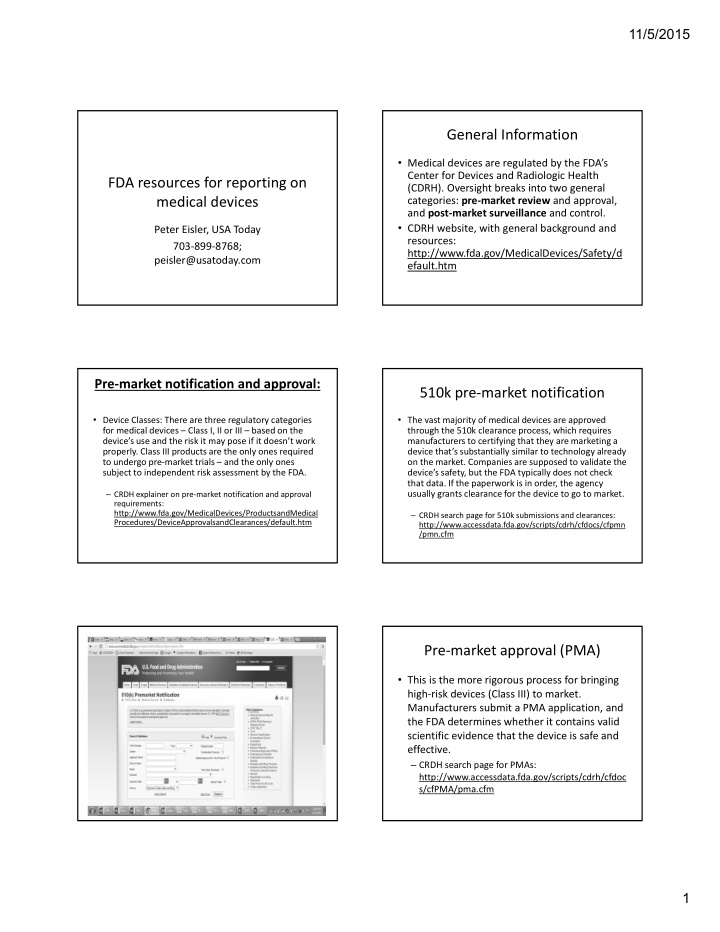



11/5/2015 General Information • Medical devices are regulated by the FDA’s Center for Devices and Radiologic Health FDA resources for reporting on (CDRH). Oversight breaks into two general medical devices categories: pre‐market review and approval, and post‐market surveillance and control. • CDRH website, with general background and Peter Eisler, USA Today resources: 703‐899‐8768; http://www.fda.gov/MedicalDevices/Safety/d peisler@usatoday.com efault.htm Pre‐market notification and approval: 510k pre‐market notification • Device Classes: There are three regulatory categories • The vast majority of medical devices are approved for medical devices – Class I, II or III – based on the through the 510k clearance process, which requires device’s use and the risk it may pose if it doesn’t work manufacturers to certifying that they are marketing a properly. Class III products are the only ones required device that’s substantially similar to technology already to undergo pre‐market trials – and the only ones on the market. Companies are supposed to validate the subject to independent risk assessment by the FDA. device’s safety, but the FDA typically does not check that data. If the paperwork is in order, the agency – CRDH explainer on pre‐market notification and approval usually grants clearance for the device to go to market. requirements: http://www.fda.gov/MedicalDevices/ProductsandMedical – CRDH search page for 510k submissions and clearances: Procedures/DeviceApprovalsandClearances/default.htm http://www.accessdata.fda.gov/scripts/cdrh/cfdocs/cfpmn /pmn.cfm Pre‐market approval (PMA) • This is the more rigorous process for bringing high‐risk devices (Class III) to market. Manufacturers submit a PMA application, and the FDA determines whether it contains valid scientific evidence that the device is safe and effective. – CRDH search page for PMAs: http://www.accessdata.fda.gov/scripts/cdrh/cfdoc s/cfPMA/pma.cfm 1
11/5/2015 Post‐market oversight, enforcement • Adverse Event Reporting: Manufacturers and health care providers (institutions and individuals) are required to file reports with the FDA when they learn of a potential safety risk with a medical device. The vast majority of this reporting is by manufacturers (the FDA has no enforcement authority over hospitals, doctors and other providers). So the FDA relies heavily on manufacturers to identify safety concerns with medical devices. MAUDE search page: • The Manufacturer and User Facility Device Experience https://www.accessdata.fda.gov/scripts/cdrh/cfdocs/cf (MAUDE) database captures the two types of reports that disclose adverse events linked to medical devices: maude/search.cfm • Medical Device Reports (MDRs): Medical device makers are required to file an MDR within 30 days of learning that a product may pose health or safety risks. While health care providers also are supposed to file MDRs under some circumstances, the vast majority come from manufacturers. All MDRs are redacted heavily to shield the identity of the hospital where the reported event occurred. • MedSun Reports: Medical Product Safety Network (MedSun) reports are generated by a network of 250 or so health care facilities that partner with CDRH to collect information about device problems in hospitals. MedSun reports tend to be more detailed and reliable than MDRs, but they cover a limited number of devices. Inspections A typical Medical Device Report (MDR) • The FDA does occasional surveillance inspections at medical device manufacturing facilities, and deficiencies are documented in Form 483s. The agency has a searchable database of 483 reports, but it’s only a list of companies for 483s have been generated (to get the actual report, you must file a request with the FDA): http://www.fda.gov/ICECI/Inspections/ucm22 2557.htm 2
11/5/2015 FDA Enforcement Actions • Press Releases: The FDA has a searchable database of press releases listing recalls, market withdrawals and safety alerts, but not all of those actions result in press releases, so the database is not comprehensive: http://www.fda.gov/Safety/Recalls/default.htm • Enforcement Reports: While not all recalls are announced in FDA releases, they all are included in the agency’s weekly Enforcement Reports – but not until they are “classified” by hazard level, which can take months. You can search enforcement reports here: • The FDA has a variety of actions it can take http://www.fda.gov/Safety/Recalls/EnforcementReports/default.htm when it learns that a medical device may pose • Warning letters: When device makers run afoul of regulatory requirements, the agency typically response with a warning letter, which safety risks – warning letters, recalls, safety lays out the problem and details the actions required to avoid legal action. These letters all are in searchable database: advisories, etc. There are several databases on http://www.fda.gov/ICECI/EnforcementActions/WarningLetters/#browse the FDA site that are useful for tracking them. • Safety Communications: If the FDA becomes aware of medical devices that may pose safety risks but don’t necessarily carry flaws that require a recall, the agency sometimes issues safety alerts or warnings to health care providers, consumers, or both. You can search those communications by word: http://www.fda.gov/MedicalDevices/Safety/AlertsandNotices/default.htm 3
Recommend
More recommend